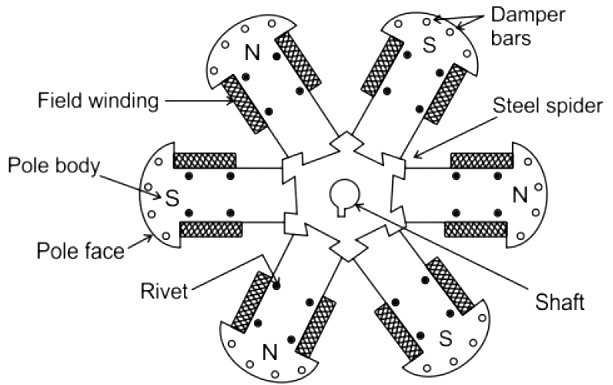If the field winding of an unloaded salient pole synchronous motor is open circuited the motor will
Right Answer is:
Run as a variable reluctance motor
SOLUTION
If the field winding of an unloaded salient pole synchronous motor is open-circuited the motor will run as a variable reluctance motor.
A conventional synchronous motor has an armature in which the emf of the machine is induced and an electromagnetic field system to produce the main magnetic field.
In a salient pole synchronous motor, in addition to the torque developed by the interaction of the magnetic field with the armature current, a torque is produced due to the difference between the direct axis and the quadrature axis synchronous reactances.

- A non-uniform air gap accompanies a salient-pole synchronous machine.
- The air gap is minimum under the pole centers, and it is maximum in between the poles.
- The pole faces are so shaped that the radical air gap length increases from the pole center to the pole tips so that the flux distribution in the air gap is sinusoidal.
- This will help the machine generate sinusoidal EMF.
- To give the alternate north and south polarities, the individual field-pole windings are connected in series.
- The end of the field windings is connected to a DC winding by the brushes on the slip-rings.
When Field current is reduced to zero:
When filed current is reduced to zero, reluctance torque comes into play. If the field winding of an unloaded salient pole synchronous motor is open-circuited the motor field current becomes zero and the synchronous motor runs as a reluctance motor.
Reluctance Torque:
- Reluctance torque is the torque generated because the motor is moving to a position where the reluctance seen by the armature flux is declining.
- Reluctance exists only when there is an unsymmetrical air gap.
- Therefore it exists only for Salient pole synchronous machines and does not exist for the cylindrical machine.
- Reluctance torque comes into play when any winding is disconnected i.e. filed winding or armature winding in the running conditions
- Reluctance torque also produces reluctance power which makes the machine more stable.
- Variable reluctance motor behaves as similar to silent pole synchronous motor unexcited.
- And after the loss of residual flux, it will run as a reluctance motor due to the generation of reluctance torque.
- The machine will continue to run at synchronous speed due to reluctance torque (i.e. even when field winding or armature windings are disconnected).
In a salient pole synchronous motor, the power flow is given by,
$P = frac{{EV}}{{{X_d}}}sin delta + frac{{{V^2}}}{2}left[ {frac{1}{{{X_q}}} – frac{1}{{{X_d}}}} right]sin 2delta$
When the field winding gets open Eb = 0
$P = frac{{{V^2}}}{2}left[ {frac{1}{{{X_q}}} – frac{1}{{{X_d}}}} right]sin 2delta$
From the above equation, it is clear that even when the field winding is open the power in the synchronous motor is generated due to which the motor continuously runs at a synchronous speed.
Note:- When the field circuit of an unloaded gradient pole synchronous motor suddenly opens, it continues to run at the same speed. Because the torque is produced in the synchronous motor due to the salient pole, which is generated due to the uneven resistance of the magnetic field.
